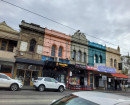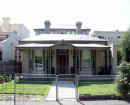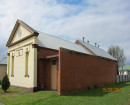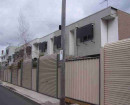GORDON RESERVE
SPRING STREET AND MACARTHUR STREET EAST MELBOURNE, MELBOURNE CITY
-
Add to tour
You must log in to do that.
-
Share
-
Shortlist place
You must log in to do that.
- Download report
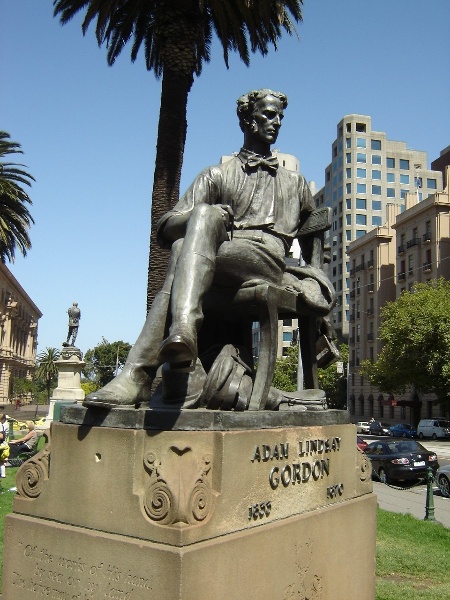

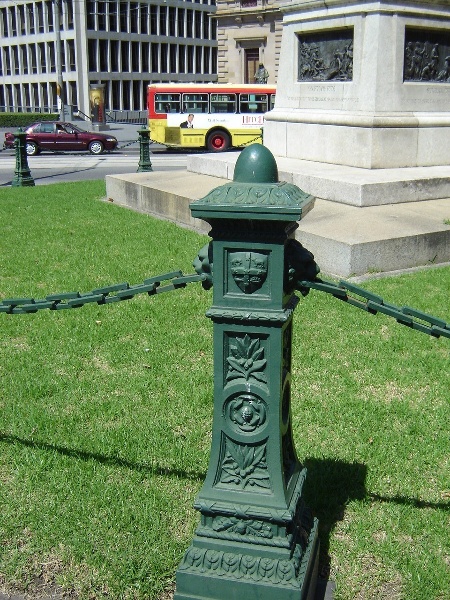
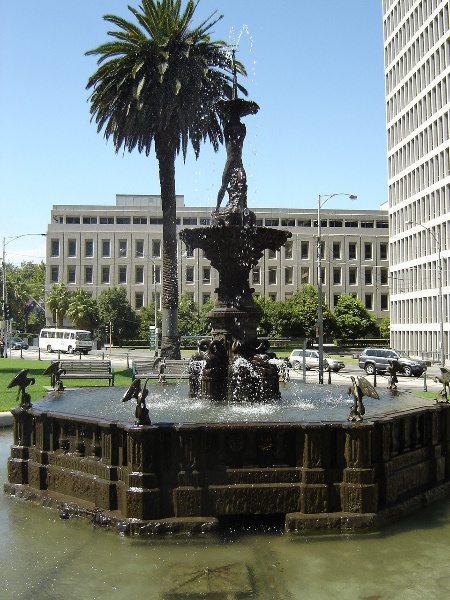

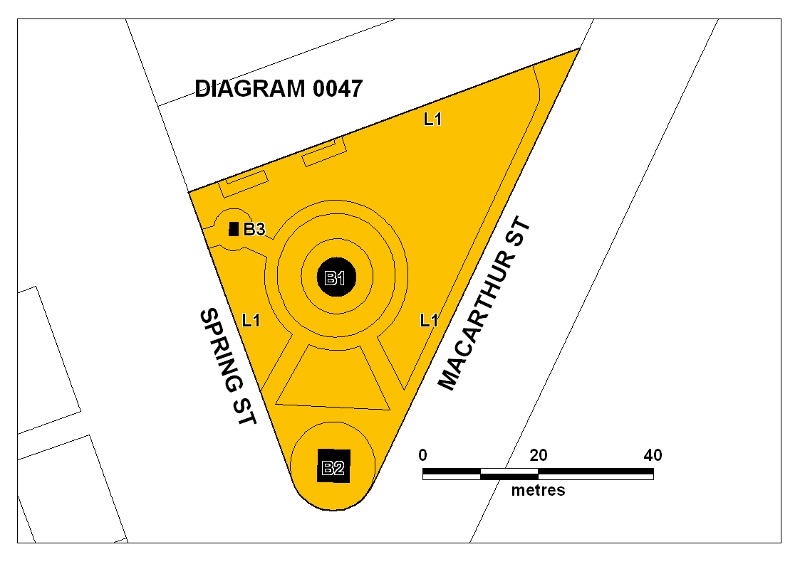
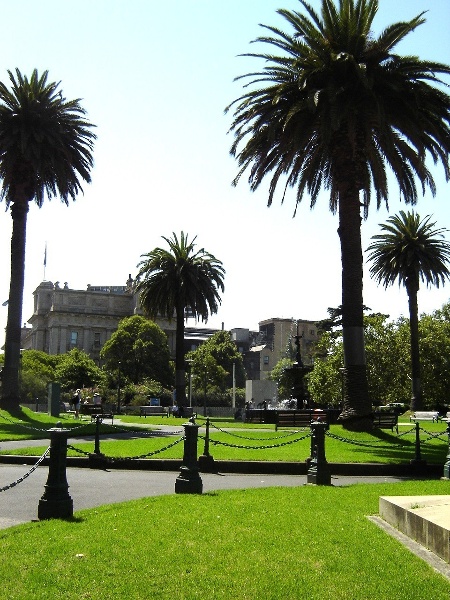
Statement of Significance
What is significant?
The Gordon Reserve is a small triangle of land bounded by Spring Street and Macarthur Street, containing the Stanford Fountain (1870), the Gordon of Khartoum Memorial (1889), the Adam Lindsay Gordon Memorial (1932), the underground women's public toilet (c1924), and five Canary Island date palms. The Reserve was originally part of the Parliament House grounds, but it became detached from these in 1863 and was called Carpentaria Place.
Early photographs of the site reveal a small fountain, paths and some plantings. In 1870 the Stanford Fountain was placed on the site. William Stanford (1839-1880) designed and carved the fountain from bluestone when he was incarcerated at Pentridge Prison. The fountain, with its birds, dolphins and central cupid figure is well executed. It was originally accompanied by eight stone benches. Photographs dating from the 1880s show the fountain to have almost disappeared from view under the foliage of the exotic plantings including weeping willows, conifers and Moreton Bay figs.
In 1889 the Statue of Gordon of Khartoum was placed on the apex of the triangle at Macarthur and Spring Streets facing towards the Treasury Reserve. General Charles Gordon (1833-1885) was killed at Khartoum, in the Sudan in January 1885. Gordon was an important figure in imperial history and his exploits in China and the Sudan were the stuff of legend before his death. A memorial was suggested and funds were raised by public subscription. The Statue is a copy of Hamo Thorneycroft's statue that had been originally destined for Trafalgar Square. The base and pedestal on the Melbourne statue differs significantly from that in London with scenes from Gordon's life rather than representations of Fortitude and Faith and Charity and Justice. The Gordon Statue is one of the first statues erected of a public figure in Melbourne (preceded by Burke and Wills in 1865 and Redmond Barry in 1887). Gordon's memorial marked the beginning of the 'heroic age of colonial statuary' with another 11 monuments being erected in Melbourne in the next twenty years.
As a part of this memorialising process the Eight Hour Movement Monument was placed at the other apex of the triangle, facing Spring Street, in 1903. Later the Eight Hour Movement Monument was moved to its present site at Russell Street and Victoria Streets opposite the Trades Hall in 1923.
The Adam Lindsay Gordon Memorial, a well executed work of sculpture by Paul Montford, was erected on the site vacated by the Eight Hour Movement Monument in 1932. This was to mark the centenary of Gordon's birth. Adam Lindsay Gordon (1833-1870) was an important figure in colonial literary history. His poetry, although well received was not successful during his lifetime and his reputation was made after his death.
The women's underground public toilet is one of a group of eleven such facilities built by the City of Melbourne between 1902 and 1939. Underground toilets were then thought to be more discreet than street level toilets, as they were out of direct public view. This group is now unique in Australia.
The five Canary Island date palm trees that can now be found at the site were planted in the early 20th Century when the plantings were rationalised and the link fences were installed that delineate the site and cordon off the General Gordon Memorial. As a consequence the site has retained its Edwardian flavour with its mixture of memorials and greenery. The site was not renamed the Gordon Reserve until the 1960s.
How is it significant?
The Gordon Reserve is of historic and aesthetic importance to the state of Victoria.
Why is it significant?
The Gordon Reserve is of historical significance as an exemplar of colonial commemoration, celebrating the redemptive qualities of the Stanford fountain, as well as the grandeur of the British Empire of the General Gordon Memorial and the creation of an Australian literary tradition in the memorialising of specific figures such as Adam Lindsay Gordon.
The Gordon Reserve is of aesthetic importance for the high quality of workmanship in the Stanford fountain, and the quality of the execution of both the General Gordon and Adam Lindsay Gordon statues.
The Gordon Reserve is of aesthetic importance for the pleasing arrangement of the various landscaping elements including the Canary Island date palms, the link fences and the memorials within the reserve.
-
-
GORDON RESERVE - History
1863 Reserve portioned off from the Parliamentary Gardens (GG 1863 p.1924)
1933 Site was permantly reserved for an ornamental garden (GG 1933. p.2659)
1961 Name changed to the Gordon Reserve (Swanson)Historic background
The Gordon Reserve is a small triangle of land bounded by Spring Street and Macarthur Street, containing the Stanford Fountain (1870), the Gordon of Khartoum Memorial (1889) and the Adam Lindsay Gordon Memorial (1932). The Reserve was originally part of the Parliament House grounds, it became detached from these in 1863 and was called Carpentaria Place, in anticipation of the Burke & Wills Memorial being placed on the site. (Government Gazette 1863 p. 1924).Early photographs of the site reveal a small fountain, paths and some plantings. (See Swanson and SLV Picture Collection). In 1870 the Stanford Fountain was placed on the site. William Stanford (1839-1880) designed and carved the fountain from bluestone when he was incarcerated at Pentridge Prison. Stanford was in jail for robbery and theft, believing himself innocent of all except one charge Stanford became an intransigent prisoner and was placed in solitary confinement until his talent for carving was discovered. The fountain appears to have been assembled at the site while Stanford remained in prison. He was released in 1871 and had a successful career as a monumental mason. (See Stanford's ADB entry). The fountain, with its birds, dolphins and central cupid figure is well executed. See Stanford's notebook in the SLV, this has drawings of figures, dolphins even, a fountain, but not the one at the Gordon Reserve. The notebook puts paid to the notion that the figure of the cupid/putti at the apex of the fountain was modelled on one of the warder's children. It would be more likely that it is a copy or a slight reworking of an antique copy several of which in different poses can be found in the notebook. The fountain was originally accompanied by eight stone benches.
In 1889 the Statue of Gordon of Khartoum was placed on the apex of the triangle at Macarthur and Spring Streets facing towards the Treasury Reserve. General Charles Gordon (1833-1885) was killed at Khartoum, in the Sudan in January 1885. Gordon?s death was marked by an outpouring of public grief. Gordon was an important figure in imperial history and his exploits in China and the Sudan were the stuff of legend before his death. Gordon?s reputation is much debated in historical sources.
A memorial was suggested and funds were raised by public subscription. The sum of the funds raised was so great that after the statue was completed the monies were used to help establish the Gordon Institute in Geelong. The Statue is a copy of Hamo Thorneycroft's statue that was originally in Trafalgar Square, but now sits on the Victoria Embankment in London. The base and pedestal on the Melbourne statue differs significantly from that in London with scenes from Gordon's life rather than representations of Fortitude and Faith and Charity and Justice found in London. Thorneycroft also designed the links and bollards that cordon off the Gordon statue from the rest of the site. The Gordon Statue is only the third erected of a public figure in Melbourne (Burke and Wills 1865 and Redmond Barry 1887). Gordon's memorial marked the beginning of the 'heroic age of colonial statuary' (Davison The Use and Abuse of History) with another 11 monuments being erected in Melbourne in the next twenty years. See Graeme Davison's the Use and Abuse of History for more work on the memorialising process. Also Ron Ridley's book on A walking guide to Melbourne's Monuments.
As a part of this memorialising process the Eight Hour Movement Monument was placed at the other apex of the triangle, facing Spring Street, in 1903. The Eight Hour Movement Monument was moved to its present site at Russell Street and Victoria Streets opposite the Trades Hall in 1923. This altered the route of the Eight Hour parade for both moves.
The Adam Lindsay Gordon Memorial, a well executed work of sculpture by Paul Mountford, was erected on the site vacated by the Eight Hour Movement Monument in 1932. This was to mark the centenary of Gordon's birth. Adam Lindsay Gordon (1833-1870) was an important figure in colonial literary history. He was a policeman, a champion jockey and a poet. His poetry, although well received was not successful during his lifetime and his reputation was made after his death. He is said to have influenced the bush balladeers of the 1890s (The Bulletin) and his writings appeared for many years in the Victorian School readers. His suicide at Brighton Beach in his 30s cemented a romantic legend.( See Gordon's entry in the ADB also Richard White's Inventing Australia)
GORDON RESERVE - Permit Exemptions
General Exemptions:General exemptions apply to all places and objects included in the Victorian Heritage Register (VHR). General exemptions have been designed to allow everyday activities, maintenance and changes to your property, which don’t harm its cultural heritage significance, to proceed without the need to obtain approvals under the Heritage Act 2017.Places of worship: In some circumstances, you can alter a place of worship to accommodate religious practices without a permit, but you must notify the Executive Director of Heritage Victoria before you start the works or activities at least 20 business days before the works or activities are to commence.Subdivision/consolidation: Permit exemptions exist for some subdivisions and consolidations. If the subdivision or consolidation is in accordance with a planning permit granted under Part 4 of the Planning and Environment Act 1987 and the application for the planning permit was referred to the Executive Director of Heritage Victoria as a determining referral authority, a permit is not required.Specific exemptions may also apply to your registered place or object. If applicable, these are listed below. Specific exemptions are tailored to the conservation and management needs of an individual registered place or object and set out works and activities that are exempt from the requirements of a permit. Specific exemptions prevail if they conflict with general exemptions. Find out more about heritage permit exemptions here.Specific Exemptions:General Conditions: 1. All exempted alterations are to be planned and carried out in a manner which prevents damage to the fabric of the registered place or object.General Conditions: 2. Should it become apparent during further inspection or the carrying out of works that original or previously hidden or inaccessible details of the place or object are revealed which relate to the significance of the place or object, then the exemption covering such works shall cease and the Executive Director shall be notified as soon as possible. Note: All archaeological places have the potential to contain significant sub-surface artefacts and other remains. In most cases it will be necessary to obtain approval from Heritage Victoria before the undertaking any works that have a significant sub-surface component.General Conditions: 3. If there is a conservation policy and plan approved by the Executive Director, all works shall be in accordance with it. Note: The existence of a Conservation Management Plan or a Heritage Action Plan endorsed by Heritage Victoria provides guidance for the management of the heritage values associated with the site. It may not be necessary to obtain a heritage permit for certain works specified in the management plan.General Conditions: 4. Nothing in this determination prevents the Executive Director from amending or rescinding all or any of the permit exemptions.General Conditions: 5. Nothing in this determination exempts owners or their agents from the responsibility to seek relevant planning or building permits from the responsible authorities where applicable.Minor Works : Note: Any Minor Works that in the opinion of the Executive Director will not adversely affect the heritage significance of the place may be exempt from the permit requirements of the Heritage Act. A person proposing to undertake minor works may submit a proposal to the Executive Director. If the Executive Director is satisfied that the proposed works will not adversely affect the heritage values of the site, the applicant may be exempted from the requirement to obtain a heritage permit. If an applicant is uncertain whether a heritage permit is required, it is recommended that the permits co-ordinator be contacted.Landscape Permit Exemptions* Repairs, conservation, and maintenance to hard landscape elements, steps, paths, paths and gutters, drainage and irrigation systems, edging, and fences.
* The process of gardening; mowing, hedge clipping, bedding displays, removal of dead plants, disease and weed control, emergency and safety garden works.
In accordance with s92(3) of the Heritage Act 2017, permit exemption issued by the Executive Director, Heritage Victoria on 4 January 2023 (P37783):- Installation of temporary events, decorations and structures associated with the City of Melbourne’s municipal Christmas celebrations for up to 60 calendar days (within one calendar year) inclusive of bump in and bump out, with no further structures erected in the same location for a period of 7 calendar days for hard stand surfaces, or 14 days for turf surfaces. The following temporary event infrastructure can be installed:
- The installation of temporary structures, such as marquees, tents, market stalls, display cases and furniture, gazebos, and shipping containers.
- The installation of temporary freestanding services associated with events, including generators and associated service cabling.
- The installation of temporary freestanding audio-visual and broadcasting equipment, including temporary staging, flooring, rigging, screens, speakers, lighting and associated infrastructure.
- The erection of temporary freestanding scaffolding towers, projectors and infrastructure associated with lightshows and projections onto, or into airspace within the extent of registration of registered places and objects.
- The installation of temporary freestanding artworks.
- The installation of freestanding temporary recreation and entertainment facilities, equipment and structures, such as jumping castles, amusement rides, and sporting equipment.
- The installation of temporary decorations, such as decorative lights, bunting, tinsel, cut floral arrangements, freestanding garden beds and the like.
- The installation of equipment and infrastructure associated with firework, laser and drone displays.
- The parking, installation and operation of temporary micro-tenancies, such as food trucks and coffee carts.
- The installation of temporary furniture, including tables, desks, chairs, umbrellas and the like.
- Installation of temporary portable toilets.
- Installation of temporary operational, promotional, directional and wayfinding signage.
- Installation of temporary surveillance systems.
- The erection of freestanding fencing structures associated with temporary events.
- The following exemption conditions apply to this event:
- Works and activities must be entirely reversible, and not involve damage to, or removal or disturbance of, early or original fabric , including landscape features such as historical planting schemes, paths and ground-surface masonry, built structures (including interiors and exterior elements), or historical archaeological remains.
- Temporary structures and associated elements exempted must be freestanding and not involve new penetrations into or affixings to early or original fabric.
- There must be no subfloor/subsurface/excavation works or activities.
- Cabling and associated service conduits must not be affixed to early or original fabric.
- Outdoor temporary structures must not be positioned within a structural root zone, or within two metres of garden beds.
- Works or activities within tree protection zones must be in accordance with a Tree Protection Management Plan prepared by a qualified arborist.
- Outdoor temporary structures are exempt within tree protection zones only if works and activities are undertaken in accordance with a Tree Protection Management Plan prepared by a qualified arborist.
- In tree protection zones the method of affixing temporary outdoor structures to the ground must be in accordance with advice provided by a Tree Protection Management Plan prepared by a qualified arborist.
- Any works or activities involving the attachment of temporary decorations, artworks or lights to trees must be guided by a Tree Protection Management Plan prepared by a qualified arborist.
- Plant and equipment access must use existing paths and access routes where possible. Existing paths and access routes must not be damaged, widened or extended.
- Tree canopy and fragile surfaces such as turf, soft landscaping, timber flooring and groundsurface masonry (excluding concrete or asphalt), must be protected from temporary structures and associated installation activities (for example the use of sleepers, boards, track matting or other ground protection). Vehicles must not use access routes through floorboarded, decked or tiled locations.
- All works and activities must comply with the internal and external engineering and loading requirements of the place.
- Any area(s) impacted by works and activities must be fully remediated to its previous condition within 28 calendar days of removal of temporary structures.
- General Exemptions related to temporary events and structures apply in addition to this specific exemption.
- Installation of temporary events, decorations and structures associated with the City of Melbourne’s municipal Christmas celebrations for up to 60 calendar days (within one calendar year) inclusive of bump in and bump out, with no further structures erected in the same location for a period of 7 calendar days for hard stand surfaces, or 14 days for turf surfaces. The following temporary event infrastructure can be installed:
-
-
-
-
-
ROSAVILLE
 Victorian Heritage Register H0408
Victorian Heritage Register H0408 -
MEDLEY HALL
 Victorian Heritage Register H0409
Victorian Heritage Register H0409 -
TRADES HALL
 Victorian Heritage Register H0663
Victorian Heritage Register H0663
-
'CARINYA' LADSONS STORE
 Victorian Heritage Register H0568
Victorian Heritage Register H0568 -
1 Alexander Street
 Yarra City
Yarra City -
1 Botherambo Street
 Yarra City
Yarra City
-
-






